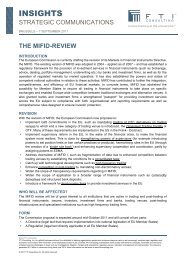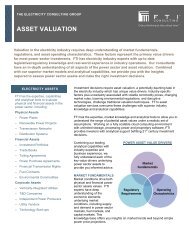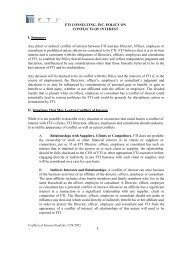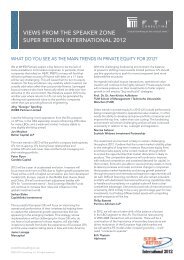Read White Paper - FTI Consulting
Read White Paper - FTI Consulting
Read White Paper - FTI Consulting
You also want an ePaper? Increase the reach of your titles
YUMPU automatically turns print PDFs into web optimized ePapers that Google loves.
NETWORK EFFECTS<br />
By Bruce Benson, Senior Managing Director, <strong>FTI</strong> <strong>Consulting</strong><br />
Introduction<br />
There are two key types of network structures. The first<br />
type is the “one-to-many” network, like a TV broadcast<br />
network, which broadcasts from the center of the network,<br />
but the individual participants cannot interact. They<br />
second type, which we call “many-to-many” networks, are<br />
ones in which consumers can interact with one another.<br />
Verizon’s cellular network is an example.<br />
The companies that<br />
master these network<br />
effects are the ones<br />
most likely to prosper<br />
disproportionately in<br />
today’s internet economy.<br />
In this paper we describe the key economic rules that<br />
govern the emergence, growth and competitive behavior of many-to-many networks. These networks masquerade<br />
as social networks, exchanges, peer-to-peer sites, telephone networks, chat networks, dating sites,<br />
tweets, wikis, etc. But at the heart of them all is the key element that the network becomes more useful as<br />
more people join. Such networks at scale have extraordinary resistance to competitors because participants<br />
want the largest gathering place possible. As we write this, Facebook now has 700 million members and will<br />
probably reach a billion before the end of 2011. Today it is estimated to be worth over $100 billion dollars.<br />
Several of these networks like LinkedIn are gearing up for their IPO. YouTube was bought by Google for $3<br />
billion, and EBay is the largest auction site in the world. As we write this article, the VC community is scrambling<br />
to fund any startup that exhibits these “network effects”.<br />
On the internet it is easy to create these types of networks. Unlike their physical equivalent, such as a capitalintensive<br />
cell-phone network, these virtual internet networks can be set up in days. Economists have been<br />
studying the behavior of networks for quite some time in a field they call network economics. It is the study of<br />
goods and services whose usefulness is determined, in whole or in part, by the number of other consumers<br />
that use them. They say such goods and services exhibit “network effects” or network externalities. Several<br />
books such as Information Rules 1 were written during the first dot.com that brought the concept of network<br />
economics into the spotlight. However, these books did not anticipate how pervasive these many-to-many<br />
networks would become. The goal of this article is to resuscitate some of these principles, bring in some of the<br />
newer thinking from economists, and describe a few principles of our own. Indeed, it is not too much to suggest<br />
that those companies that master these new network effects are the ones most likely to prosper disproportionately<br />
in today’s internet economy.<br />
The Behavior of Network Goods<br />
A Definition. We will coin the terms network goods or network-dependent goods to mean a product or service<br />
whose usefulness is determined by the size of its network of members. Skype, eBay, faxes, telephones,<br />
and MySpace are network-dependent goods. If their users couldn’t interact, they’d be useless, and the more<br />
members, the more useful they become. Note that all these types of services require a many-to-many network<br />
1<br />
Information Rules by Carl Shapiro and Hal Varian, Harvard Business School Press, 1999<br />
<strong>FTI</strong> CONSULTING | ADVANCED AD OPTIMIZATION RAISES REVENUE AND REDUCES COSTS IN TELEVISION AND RADIO 2
















